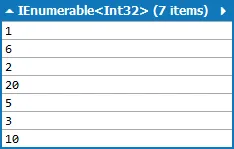刚刚为此编写了一个小扩展程序:
public static class MyEnumerable
{
public static IEnumerable<T> Smash<T>(this IEnumerable<T> one, IEnumerable<T> two)
{
using (IEnumerator<T> enumeratorOne = one.GetEnumerator(),
enumeratorTwo = two.GetEnumerator())
{
bool twoFinished = false;
while (enumeratorOne.MoveNext())
{
yield return enumeratorOne.Current;
if (!twoFinished && enumeratorTwo.MoveNext())
{
yield return enumeratorTwo.Current;
}
}
if (!twoFinished)
{
while (enumeratorTwo.MoveNext())
{
yield return enumeratorTwo.Current;
}
}
}
}
}
使用方法:
var a = new List<int> { 1, 2, 5, 10 };
var b = new List<int> { 6, 20, 3 };
var c = a.Smash(b); // 1, 6, 2, 20, 5, 3, 10
var d = b.Smash(a); // 6, 1, 20, 2, 3, 5, 10
这将适用于任何
IEnumerable,因此您也可以执行以下操作:
var a = new List<string> { "the", "brown", "jumped", "the", "lazy", "dog" };
var b = new List<string> { "quick", "dog", "over" };
var c = a.Smash(b);

a1,a2,a3和b1,b2,b3,b4,b5,您想要的结果是a1,b1,a2,b2,a3,b3,b4,b5? - Lasse V. Karlsen